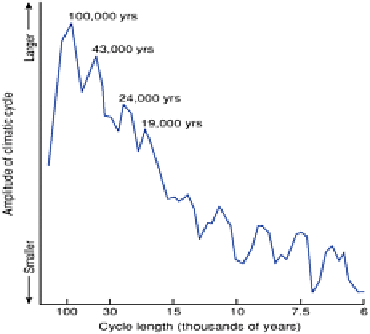Environmental Engineering Reference
In-Depth Information
tilt, the position of the overhead sun at midday at the solstices is further polewards by
about 2·5° than when the tilt is smallest. This produces greater seasonal contrast with
high tilt and less contrast with a small tilt. The variation is sometimes referred to as the
obliquity of the ecliptic
, or more simply as the variation in tilt, and takes place over a
full cycle of approximately 41,000 years.
The impact of the variations in the solar radiation due to orbital changes varies with
latitude. In high latitudes it is the 41,000 year cycle which dominates, whilst at lower
latitudes the 22,000 year cycle is dominant. From the amounts of incoming radiation,
with an allowance for ice cover, calculations of Earth's energy budget indicate that the
orbital variations have the correct timing and size to start the succession of major
advances and retreats of the ice sheets during the last 300,000 years. This is seen most
clearly in some of the ocean cores, where undisturbed sediments have accumulated over
thousands of years. Fluctuations in temperature are determined from their fossil and
carbonate contents and do show strong links with the Milankovich cycles (Figure 9.11).
However, the graph shows that it is the longest cycle - the eccentricity - which produces
the dominant signal in the sediments, despite the fact that it causes only small variations
in global solar radiation compared with the other two factors.
There are a number of other problems when trying to link orbital parameters with the
oceanic and ice core records. According to Milankovich, the eccentricity peak should be
split into two elements with periods of 95,000 and 125,000 years, but the data indicate a
single narrow peak. Global ice indications are that prior to 1 million years ago, ice
volume was dominated by the obliquity signal, but thereafter the eccentricity signal has
become dominant. As yet we are unable to explain this feature. Again in the global ice,
the precession component is consistently small; the signal is dominated by obliquity for
reasons we cannot explain. Finally there is the problem that orbital processes change
slowly, whilst there is
Figure 9.11
Spectrum of climatic variation over the past half-
million years. This graph - showing the relative importance
of different orbital cycles in the isotope record of two Indian

